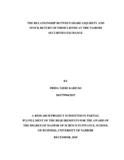| dc.contributor.author | Kariuki, Frida Njeri | |
| dc.date.accessioned | 2019-01-18T13:03:56Z | |
| dc.date.available | 2019-01-18T13:03:56Z | |
| dc.date.issued | 2018 | |
| dc.identifier.uri | http://hdl.handle.net/11295/105108 | |
| dc.description.abstract | The objective of the study was to determine the relationship between stock returns and share liquidity for firms listed at the NSE. The research design was descriptive aimed at finding the correlation between share return and share liquidity. The population of the study was 62 listed companies and purposive sampling was applied where 53 firms were selected for a 60 months period, January 2013 to December 2017, excluding firms listed during the period or firms that had their share trading suspended in the period. Turnover ratio was used as liquidity proxy measured as the ratio between monthly traded share volume and issued shares. Stock return comprised of holding period yield and dividend yield. Stock beta, inflation rate and 91 days Treasury bill rate were included as control variables. Secondary monthly data was collected and analysed for the five variables. Panel data analysis was used to determine the nature of the relationship in exclusion of macroeconomic variables while time series data analysis was used to analyse the nature of the relation with inclusion of macroeconomic variables. Both correlation analysis and regression analysis showed that the relationship between share liquidity and stock return to be very low, positive and significant when firm specific variables were used. However the liquidity return relationship became insignificant on inclusion of macroeconomic variables. The relationship between share return and stock beta, inflation rate and 91 days T-bill rate were insignificant in both analyses. The coefficient of determination showed that very little variation in stock return can be explained by the models. This shows that liquidity as measured by turnover ratio does not influence stock return. This could be due to the low trading in the NSE and thus investors may not view it as a risk factor. The study thus recommends policy makers to come up with strategies to improve trading in the market and thus improve liquidity. | en_US |
| dc.language.iso | en | en_US |
| dc.publisher | University of Nairobi | en_US |
| dc.rights | Attribution-NonCommercial-NoDerivs 3.0 United States | * |
| dc.rights.uri | http://creativecommons.org/licenses/by-nc-nd/3.0/us/ | * |
| dc.title | The Relationship Between Share Liquidity And Stock Return Of Firms Listed At The Nairobi Securities Exchange | en_US |
| dc.type | Thesis | en_US |



